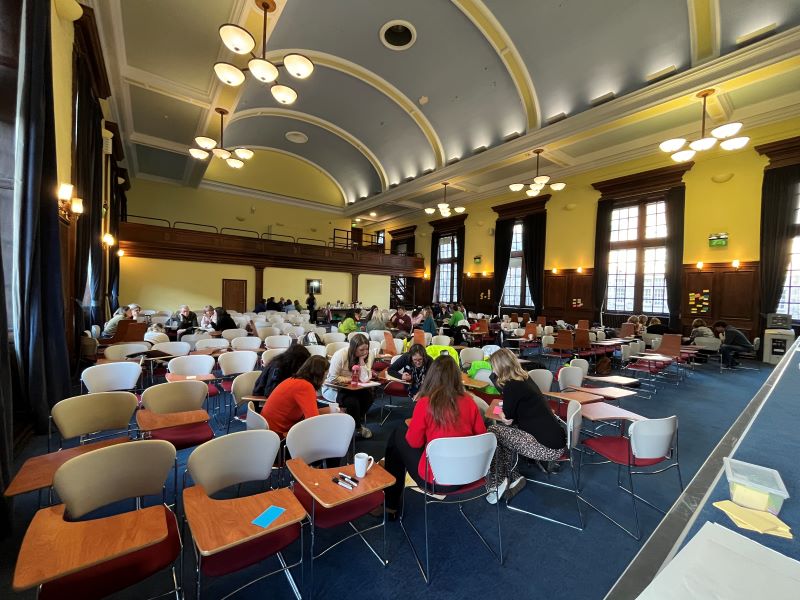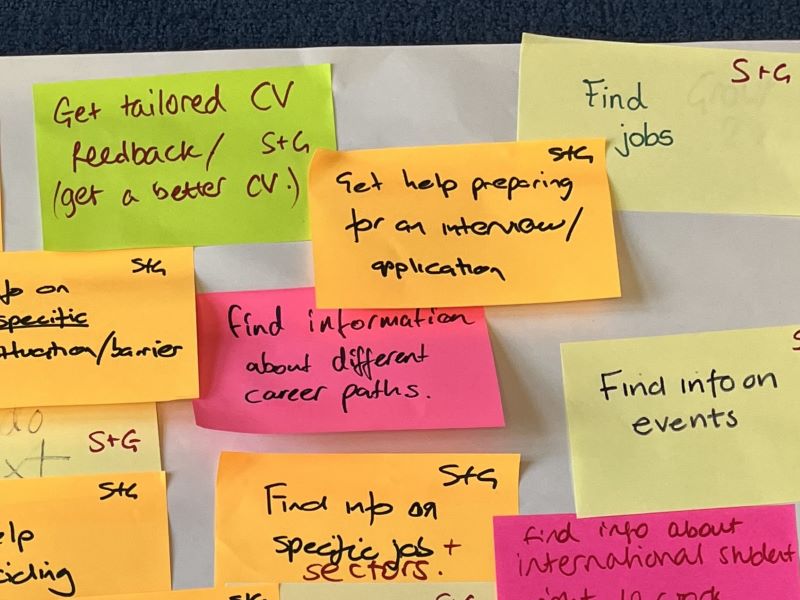Working with the Careers Service on their content strategy
The User Experience Service have been working with the Careers Service to improve their web content. In January, we ran a workshop to help the Careers Service to think through the foundations of their content strategy.
Migration prompted publishers to reassess their content
Last year’s migration of sites to our new content management system EdWeb 2 prompted many publishers to take a fresh look at their content.
Ahead of the migration, publishers were asking questions such as:
- What content are we going to keep?
- What’s the best way to organise our content?
- How is my content going to work in the new platform?
Underpinning all of this is often a more strategic question: how can we get our site to work best for our service and our users?
We developed our training session Content Design for Web Publishers in part to help colleagues address this question. A positive side effect of running the training was that we got to chat to colleagues face to face about the work that’s involved with managing a website at the University.
These conversations led to some follow-up meetings with the Careers Service to work on user research and content strategy. As part of this, we proposed running a workshop with Careers Service staff to focus on their content strategy.
What is content strategy?
There isn’t a single definition of content strategy that everyone uses.
Kristina Halvorson, author of Content Strategy for the Web, has proposed this as a possible definition:
Content strategy guides planning for the creation, delivery, and governance of useful, usable content
What is content strategy? Connecting the dots between disciplines (Kristina Halvorson)
Writing for Nielsen Norman Group, Anna Kaley defines it this way:
A high-level plan that guides the intentional creation and maintenance of information in a digital product.
Content Strategy 101 (Nielsen Norman Group)
We ran a content strategy workshop for the Careers Service
A content strategy needs to address the audience and purpose of the content. A workshop is a good format to find out about this, because you get to hear from a wide variety of stakeholders in a relatively short period of time.
Staff working across the Careers Service have an interest in the website and want the content to work well for their users. With 40 Careers Service staff attending a team away day in January this year, we had an opportunity to:
- hear from staff working across the Careers Service
- clarify internal perceptions of what their website needs to do
- discuss the role that their website plays in service delivery.
The aim of the workshop was to help the Careers Service focus on what they want to achieve with their site, and to think about the tasks that users want to complete when they’re using it.
Ahead of the workshop, the Careers Service told us they wanted to prioritise two audience groups for this piece of work: current students and graduates.

Group work in our workshop with the Careers Service.
The workshop involved brainstorming and prioritisation exercises
The workshop looked at:
- Business objectives: what the Careers Service want to achieve with their website
- User needs: what users of the Careers Service want to achieve with their website.
For an introduction to this approach, see this post by Lou Rosenfeld:
Stop redesigning and start tuning your site instead
There were three main activities in the workshop:
- Business objectives
- User needs
- Bringing it all together
Business objectives
First, Careers Service staff worked in groups to brainstorm a list of business objectives: tasks that they might want current students and graduates to complete on or through their site.
For example, the Careers Service might want their users to:
- find out about careers events and fairs
- use self-service toolkits, especially ahead of a consultation meeting
- find information about specific employers.
With the ideas written out on sticky notes, the groups worked on prioritising the tasks from most to least important.
User needs
Next, we repeated this activity, but this time participants looked at the website from the users’ perspective. So here we want to know about the tasks that users are aiming to complete on the Careers Service site.
Again, participants prioritised these user needs based on their current understanding of what matters to current students and graduates who use the service.
We phrased these user needs in the format “As a [user type], I need to [task]”.
For example, as a current student, I need to:
- find a job
- get help with my CV
- book an appointment with a careers advisor.
The user needs that you generate in a workshop like this are assumptions that you need to cross-check with other user research. But in the case of the Careers Service, many staff have regular interactions with the students who use the service. So it was a good opportunity to get some of those impressions down on paper while we had everyone in the same room.
Bringing it all together
Finally, participants consolidated everything we discussed in the first two activities. This final stage was about boiling down what was written on the sticky notes and recording what stood out as common priority items.

The workshop helped to clarify priorities
Priorities help you to make decisions about your site
Setting out their business objectives and user needs gives the Careers Service an excellent starting point for working on their content, because it helps them to decide what they are going to focus on. When you know what your priorities are, you can make decisions about:
- what you will include on your site
- what you will make prominent and easy to find
- where you will focus your content development effort
Priorities help you to assess your site
Having greater clarity on the purpose of their site also puts the Careers Service in a better position to test their site and assess how well it is working. How easy is it for someone to complete the priority tasks on the site? What happens when a student visits their site and tries to find a job or get help writing a CV? When it comes to testing their site with users, the Careers Service will have ideas for which tasks they want to ask people to attempt on the site.
The Careers Service are now in a better place to develop their content
It’s been great working with the Careers Service on this project. The workshop generated a lot of discussion about the role the site plays in supporting students through their degrees and into the world of work, and it was clear from the discussions on the day that there was a common interest in making the website work more effectively. We’re excited to see the next stages of the Careers Service’s work to develop their digital content.
How we can help you
If you’d like to talk to us about developing your content and making your site more effective, get in touch:
Or read some of our other posts about our consulting work:

